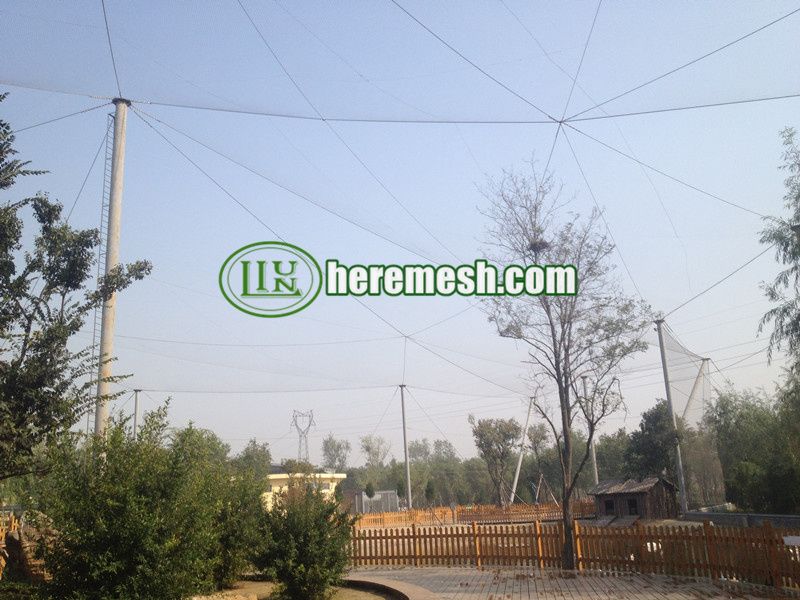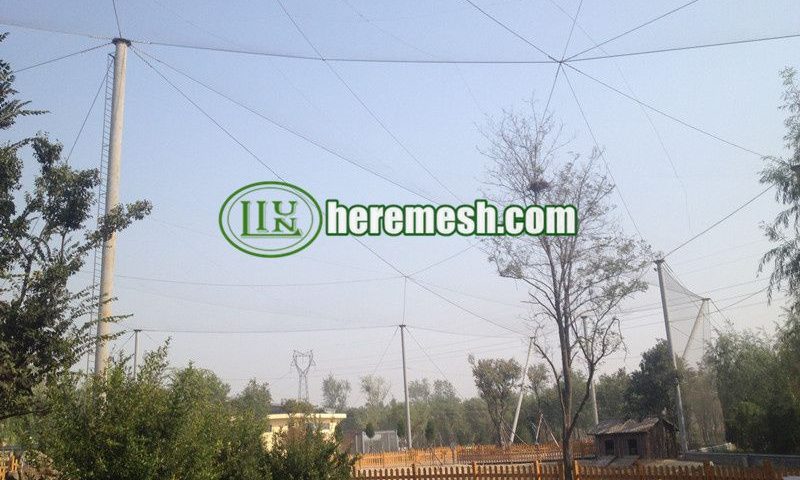High-Performance Outdoor Aviary Roof Metal Mesh

Monkey Tunnel Mesh Order: Enhancing Primate Welfare
11/14/2025In the increasingly close interaction between humans and nature, bird conservation and observation have become integral parts of modern life. Whether in bird-watching areas of urban parks or aviaries within zoos, bird enclosures—as shelters provided by humans for birds—directly impact the survival quality and safety of avian species through their design and construction. Among the various components of a birdhouse, the outdoor aviary roof metal mesh – a component that is often overlooked but is of crucial importance – is redefining the boundaries of the bird enclosure space with its outstanding performance. It embodies humanity’s commitment to animal welfare, representing an aesthetic fusion of technical rationality and ecological ethics.
Technical Evolution of Outdoor Aviary Roof Metal Mesh
Traditional aviary roof netting has undergone experimentation with various materials.
Early aviaries predominantly featured wooden or bamboo frames paired with metal wire mesh. Ordinary iron wire mesh was prone to rust and corrosion, resulting not only in a short lifespan but also posing risks of skin damage to birds from rust particles, potentially leading to poisoning. Galvanized iron wire mesh offered some improvement, yet the zinc coating could be pecked off by birds, causing heavy metal poisoning. Nylon netting exhibited poor UV resistance, rapidly deteriorating and becoming brittle in outdoor environments, while also proving vulnerable to punctures from sharp objects.
Advancements in materials science gradually brought outdoor aviary roof metal mesh into focus. Among these, stainless steel rope netting emerged as the most widely adopted solution. This netting is formed by weaving cables composed of multiple strands of ultra-fine stainless steel wire. Combining high strength, exceptional flexibility, and ultimate durability, it stands as the optimal solution for outdoor aviary roofing.
From wire mesh to stainless steel rope netting, this is not just a material upgrade. It represents an innovation in design philosophy. The focus shifts from simply caging birds to creating a safe and healthy habitat for them. This simulated natural environment is built to last.
Crafting Process for the Outdoor Aviary Roof Metal Mesh
Precision Weaving: Balancing Rigidity & Flexibility
Weaving is key to producing outdoor aviary roof metal mesh. Modern techniques go beyond simple crisscross patterns. They focus on mimicking nature’s flexible properties. Skilled hand-weaving enables flexible connections at every knot. This creates a three-dimensional network with slight elasticity. The net absorbs and disperses impact force through minor deformation when stressed. It acts like a safe cushion for birds. This minimizes injuries from rigid collisions. The diamond pattern is widely used for optimal stability. It ensures even stress distribution across the netting. This prevents any weak spots from forming.
Seamless & Secure Connection
The sturdiness and smoothness of nodes are crucial for bird safety. Advanced manufacturing avoids any extra metal fasteners. Instead, it uses high-strength integrated weaving technology. This precise technique creates a smooth, burr-free monolithic structure. This approach offers dual benefits. Firstly, it eliminates potential loosening or detachment from fasteners. It also prevents sharp edges that could injure birds’ feet or feathers. Secondly, the seamless structure provides vital safety protection. If a single strand accidentally breaks, the damage is secured by surrounding tight nodes.
Bird-Friendly Surface Finishing
The surface treatment of the outdoor aviary roof metal mesh goes far beyond just being resistant to corrosion. For birds, a highly reflective roof can be a constant visual disturbance. Therefore, advanced processes employ low-gloss oxidation treatment. This technology eliminates glaring light spots, creating a visually soft and more natural environment for the birds. At the same time, this uniform and robust protective film can effortlessly withstand sun and rain, ensuring the net structure maintains long-term stable performance and avoiding potential risks caused by coating peeling.


Why Stainless Steel Rope Mesh is the Best Choice for Outdoor Aviary Roof Mesh?
Stainless steel wire mesh offers all-around advantages for outdoor aviaries. It holds an irreplaceable position in such applications.
Its durability is truly outstanding. High-quality stainless steel mesh lasts over 20 years outdoors. It requires no frequent replacement or special maintenance. It withstands sun, rain, and temperature changes without issue. Its tensile strength exceeds 600MPa, resisting hail, strong winds, and impacts.
Safety is its core advantage. Without zinc, without lead, and without the risk of coating peeling off. The stainless steel outdoor aviary roof metal mesh fundamentally eliminates the possibility of heavy metal poisoning. Its smooth surface prevents bird injuries from snags. Proper mesh size, typically 25mm×25mm to 50mm×50mm, prevents escape or head entrapment. It also allows birds to climb freely.
Its eco-friendliness is equally excellent. The material is non-toxic and 100% recyclable. The mesh structure ensures good ventilation and light penetration. It also allows rainwater to enter naturally, providing clean water.
It balances vision and function perfectly. Thin wire diameters, usually 1.2mm-3.2mm, minimize visual obstruction. This offers viewers an almost unobstructed experience. Its silver-gray hue blends naturally into various landscapes.
Maintenance is notably convenient. The surface of the stainless steel outdoor aviary roof metal mesh is smooth and does not accumulate dirt. It can be kept clean simply by being washed with rainwater. Occasional use of neutral cleaner restores its look. Repairs are simple; local damage can be fixed with special tools without full replacement.
Design Considerations
Choosing and installing stainless steel rope mesh is a systematic project. It requires comprehensive consideration of various factors.
Selection parameters include rope diameter, mesh size, and material grade. Diamond-shaped meshes offer the best visibility and higher stability. Rope diameter selection must balance strength and transparency. Main support ropes can use 2.0mm-3.2mm. Internal meshes typically require only 1.2mm-2.0mm. Mesh size must be smaller than the standing bird’s body width. Areas with strong environmental corrosion should prioritize 316-grade material.
Structural design requires scientific calculation. Mesh pre-tension design is a key step. Proper tensioning prevents excessive sagging when birds perch.
Border fixation technology directly impacts overall safety. Concrete beam embedded parts are the most secure. They are suitable for new enclosures. Chemical anchors can be used on existing structures. Anchoring depth must meet requirements. All metal connectors should use the same material. This avoids electrochemical corrosion.
Anti-escape design requires thorough planning. The top edge net should incline inward at 45-60 degrees. This forms an anti-escape overhang. Waterproof sealing is needed where the mesh connects to walls. It also prevents birds from pecking gaps. The mesh around door openings requires extra reinforcement. These areas experience concentrated stress.


The Multifaceted Applications of Outdoor Aviary Roof Metal Mesh
The application of stainless steel rope mesh has far exceeded the traditional scope of bird enclosures and is playing a significant role in multiple fields.
In the field of bird conservation, outdoor breeding grounds for large and rare birds are a typical application. For instance, large birds such as cranes and storks require spacious flying areas. The stainless steel rope netting provides an indispensable top-level protection. The flight training grounds of the bird rehabilitation center are also applicable. Here, injured birds regain their flying abilities, and the safety of the net structure is of utmost importance.
In the field of ecological architecture, the immersive exhibition areas of zoos use the stainless steel outdoor aviary roof metal mesh to create a visually barrier-free viewing experience. The bird-language forest in the botanical garden relies on its ability to create a natural ecological environment. The walk-through aviaries in the urban ecological corridors also use this type of netting to guide birds safely through areas where human activities take place.
In the field of specialized agriculture, high-value poultry farms such as peacock farms and ostrich farms rely on stainless steel rope nets for protection. The bird repelling protection in organic orchards uses these nets to prevent wild birds from pecking at the fruits. Compared to traditional bird repelling nets, this method is more humane and long-lasting.
In the field of landscape design, the integrated design of courtyard birdhouses and buildings has become a new trend. The decorative mesh structure in urban squares not only beautifies the environment but also provides temporary resting places for birds, embodying the concept of harmonious coexistence between humans and nature.


